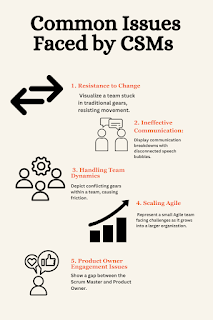Navigating Challenges: Common Issues Faced by CSMs and How to Overcome Them
Introduction
Embarking on the journey to becoming a Certified Scrum Master (CSM) is an exciting endeavor, but it comes with its fair share of challenges. As a facilitator of Agile processes, csm certification plays a key role in ensuring the success of Scrum teams. In this blog, we’ll explore some of the most common challenges facing certified Scrum Masters and provide insights on how to overcome them to foster an effective environment of collaboration and agility.
1. Resistance to change:
One of the main challenges that CSMs face is resistance to Agile practices. Team members or stakeholders may be used to traditional management styles, which makes it difficult to embrace the iterative and adaptable nature of Scrum.
Control Strategies:
Encourage open communication about the benefits of Agile methodologies. Conduct meetings or training sessions to help team members understand the principles behind Scrum and how it increases project productivity.
2. Lack of power:
In some cases, groups struggle over their policies and empowerment. A lack of clear understanding of roles and responsibilities can hinder the Agile process.
Control Strategies:
Simplify team-building activities and establish clear roles and responsibilities. Encourage team members to take ownership of their work and collaborate in decision-making processes.
3. Ineffective Communication
Agile relies heavily on communication, and disruption in this area can lead to misunderstandings, delays, and bad goals.
Control Strategies:
Encourage a culture of open and frequent communication. Use regular standing meetings, sprint reviews and retrospectives to ensure everyone is on the same page. Make good use of communication tools.
4. Undefined Race Goals:
Without clearly defined sprint goals, teams can struggle to deliver exportable product development, leading to dissatisfaction and project delays
Control Strategies:
Work closely with the product owner to set specific, achievable running goals. Engage the team in sprint planning meetings to ensure a collective understanding of all goals.
5. Inputting Product Owner Information:
Collaboration between Scrum Master and Product Owner is essential for project success. However, if the product owner is unavailable or does not have a deep understanding of Agile principles, difficulties can arise.
Control Strategies:
Facilitate consistent communication between the Scrum Master and Product Owner. Provide training or resources to enhance product owners’ agile skills and understand the importance of their role.
6. Managing Team Dynamics:
Team dynamics can be challenging and conflicts can arise. Focusing on program objectives and solving interpersonal problems is a delicate balance.
Control Strategies:
Use prompt conflict resolution techniques. Promote a culture of respect and openness within the team. Resolve conflicts promptly and promote a positive working environment.
7. Scaling Agile
As organizations grow, scaling up Agile practices becomes a challenge. CSMs may find it challenging to maintain Agile principles while adapting to larger, more complex projects.
Control Strategies:
Look for scaling frameworks like Less or Safe and tailor them to your organization’s needs. Encourage collaboration between teams and strike a balance between flexibility and structure.
Conclusion:
Becoming a Certified Scrum Master is a journey full of learning experiences and challenges. By identifying and addressing these common barriers head-on, csm certification can create a flexible and flexible Agile environment. Embrace challenges as opportunities for growth, and remember that effective communication, continuous improvement, and a commitment to agile principles are keys to removing barriers to success.


.png)
Comments
Post a Comment